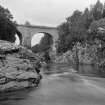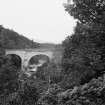Spean Bridge, General Wade's High Bridge
Road Bridge (18th Century)
Site Name Spean Bridge, General Wade's High Bridge
Classification Road Bridge (18th Century)
Alternative Name(s) High Bridge Over River Spean; Tom Na Brataich Bridge; 'high Bridge Over The Speyan'; Fort William
Canmore ID 73804
Site Number NN28SW 6
NGR NN 20059 82108
Datum OSGB36 - NGR
Permalink http://canmore.org.uk/site/73804
- Council Highland
- Parish Kilmonivaig
- Former Region Highland
- Former District Lochaber
- Former County Inverness-shire
High Bridge near Brackletter, General Wade, 1735-6 The remnants of this daring and remarkable structure remain a thrilling spectacle, riding high above a narrow gorge flushed by the fluctuating waters of the Spean. A section of cast-iron footbridge (introduced c.1894) balances precariously over the chasm on soaring stanchions with triangular cutwaters, the old military road approaching it over massive buttressed abutments. The bridge was 'in a perilous state' in 1819; it was repaired in 1893.
[The Battle of High Bridge was a famous incident heralding the Jacobite uprising of 1745. Major Macdonald of Tirnadrish ambushed and routed two companies of the Royal Scots under Captain Scott. Tirnadrish spared Scott's life, but was later captured at the Battle of Falkirk and beheaded in Carlisle.]
Taken from "Western Seaboard: An Illustrated Architectural Guide", by Mary Miers, 2008. Published by the Rutland Press http://www.rias.org.uk
NN28SW 6 20059 82108 MR 1
Not to be confused with Spean Bridge (over River Spean, in Spean Bridge village), for which see NN28SW 15.
Remains of High Bridge (AD 1736) [NAT]
OS 1:10,000 map, [no date available].
REFERENCE - Photographs: National Library of Scotland; Nattes Drawings.
20 Sept. Vol IV no 61. Drawings of High Bridge over the Speyan 8 miles from Fort William.
(Undated) information in NMRS.
High Bridge was built by General Wade in 1736 (see NN28SW 7). By the 1930's one of its 3 arches was broken and by 1979 only one survived.
Visited by OS May 1970; February 1979.
J B Salmond 1938.
This constitutes the remains of a triple arch stone bridge, known as High Bridge, which was completed in 1736. There is complete disintegration of one arch and the remainder of the bridge is threatened with imminent collapse. Although an iron truss has been positioned across the top of the bridge, it does not appear to furnish any support.
M Logie (Highland Council) 1997; NMRS MS 1007/3.
This bridge carries the line of the Wade Road MR1 over the River Spean about 2.2km WNW of Spean Bridge village (NN28SW 16).
The location assigned to this record defines the centre of the structure. The available map evidence suggests that it extends from NN c. 20046 82096 to NN c. 20070 82114.
Information from RCAHMS (RJCM), 12 April 2006.
High 3 arched rubble bridge; segmental headed dressed rubble arch rings; triangular cutwaters rising as stepped buttresses at each end abutments. Smaller east bank arch survives; section remains of cast-iron footbridge placed over missing spans, now also collapsed. Fragments of pulvinated string course survive.
High Bridge superseded by Thomas Telford's Spean Bridge further up stream. Said to have been (and still is') inscribed "In the ninth year of His Majesty King George II this bridge was erected under the care of Lt General Wade, Commander in Chief of all Forces in North Britain, 1736." In poor condition and difficult to examine owing both to condition and over-grown vegetation. (Historic Scotland)
Build (1736 - 1737)
Built by General George Wade [when building roads, barracks and bridges in Scotland in the aftermath of the Jacobite Rebellion of 1715 as 'Commander in Chief of his Majesty's forces, castle, forts and barracks in North Britain', appointed 1725].
R Paxton and J Shipway, 2007.
Publication Account (2007)
(Institute Civil Engineers Historic Engineering Works no. HEW 2539/01)
High Bridge, Spean Bridge
This bridge, now ruinous, carried the military road from Fort William to Fort Augutus and Inverness over the steep sided valley of the Spean. It had three spans of 40 ft, 50 ft and 40 ft, and crossed about 80 ft above river level. The bridge, constructed under General Wade’s direction in 1736–37, was one of the most spectacular military bridges. By 1908 it was becoming ruinous and a light iron truss had been placed across the centre span. The masonry arch collapsed in the 1930s but the piers remain
and the truss is still in place.
R Paxton and J Shipway, 2007.
Reproduced from 'Civil Engineering heritage: Scotland - Highlands and Islands' with kind permission from Thomas Telford Publishers.
Watching Brief (16 November 2010 - 19 November 2010)
NN 1991 8294 A watching brief was undertaken 16–19 November 2010 during the construction of a footpath. The path ran along the route of an 18th-century military road for 350m as it approached the Spean Bridge from the NW. The construction work revealed the original construction
of the military road in areas where it had been terraced into the slope. A road surface made from up to four layers of gravel metalling was recorded in a number of areas. At other locations only a single gravel layer was recorded; farther along the route to the SE all surface deposits had been
washed away exposing bedrock. The remains of a small substantially built masonry bridge were uncovered at one burn crossing point. Most of the N,
W and upper parts of the bridge had been washed away. However, enough masonry survived to allow the form and size of the lower parts of the bridge to be understood. The bridge was 5.2m wide (from parapet to parapet), with a 1.2m span and was carried over the burn on a vault, the lowest parts of which survive in situ to the SE. The bridge was constructed with a lime-bonded rubble face that retained an unbonded rubble fill.
Archive: The National Trust Scotland
Funder: The High Bridge Footpath Group











